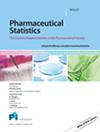A practical guide to the appropriate analysis of eGFR data over time: A simulation study
IF 1.3
4区 医学
Q4 PHARMACOLOGY & PHARMACY
引用次数: 0
Abstract
In several therapeutic areas, including chronic kidney disease (CKD) and immunoglobulin A nephropathy (IgAN), there is a growing interest in how best to analyze estimated glomerular filtration rate (eGFR) data over time in randomized clinical trials including how to best accommodate situations where the rate of change is not anticipated to be linear over time, often due to possible short term hemodynamic effects of certain classes of interventions. In such situations, concerns have been expressed by regulatory authorities that the common application of single slope analysis models may induce Type I error inflation. This article aims to offer practical advice and guidance, including SAS codes, on the statistical methodology to be employed in an eGFR rate of change analysis and offers guidance on trial design considerations for eGFR endpoints. A two‐slope statistical model for eGFR data over time is proposed allowing for an analysis to simultaneously evaluate short term acute effects and long term chronic effects. A simulation study was conducted under a range of credible null and alternative hypotheses to evaluate the performance of the two‐slope model in comparison to commonly used single slope random coefficients models as well as to non‐slope based analyses of change from baseline or time normalized area under the curve (TAUC). Importantly, and contrary to preexisting concerns, these simulations demonstrate the absence of alpha inflation associated with the use of single or two‐slope random coefficient models, even when such models are misspecified, and highlight that any concern regarding model misspecification relates to power and not to lack of Type I error control.对随时间变化的 eGFR 数据进行适当分析的实用指南:模拟研究
在一些治疗领域,包括慢性肾脏病 (CKD) 和免疫球蛋白 A 肾病 (IgAN),人们越来越关注如何在随机临床试验中以最佳方式分析随时间变化的肾小球滤过率 (eGFR) 估计数据,包括如何以最佳方式适应随时间变化的速率不是线性的情况,这通常是由于某些类别的干预措施可能会产生短期血液动力学效应。在这种情况下,监管机构表示担心普遍应用单一斜率分析模型可能会引起 I 类错误膨胀。本文旨在就 eGFR 变化率分析中应采用的统计方法提供实用建议和指导(包括 SAS 代码),并就 eGFR 终点的试验设计注意事项提供指导。本文提出了一种随时间变化的 eGFR 数据双斜率统计模型,允许同时评估短期急性效应和长期慢性效应的分析。在一系列可信的零假设和替代假设下进行了模拟研究,以评估双斜率模型与常用的单斜率随机系数模型以及非斜率基线变化分析或时间归一化曲线下面积(TAUC)相比的性能。重要的是,与之前存在的担忧相反,这些模拟结果表明,使用单斜率或双斜率随机系数模型,即使这些模型被错误地指定,也不会出现α膨胀,并强调任何有关模型指定错误的担忧都与功率有关,而不是与缺乏I类错误控制有关。
本文章由计算机程序翻译,如有差异,请以英文原文为准。
求助全文
约1分钟内获得全文
求助全文
来源期刊

Pharmaceutical Statistics
医学-统计学与概率论
CiteScore
2.70
自引率
6.70%
发文量
90
审稿时长
6-12 weeks
期刊介绍:
Pharmaceutical Statistics is an industry-led initiative, tackling real problems in statistical applications. The Journal publishes papers that share experiences in the practical application of statistics within the pharmaceutical industry. It covers all aspects of pharmaceutical statistical applications from discovery, through pre-clinical development, clinical development, post-marketing surveillance, consumer health, production, epidemiology, and health economics.
The Journal is both international and multidisciplinary. It includes high quality practical papers, case studies and review papers.
 求助内容:
求助内容: 应助结果提醒方式:
应助结果提醒方式:


